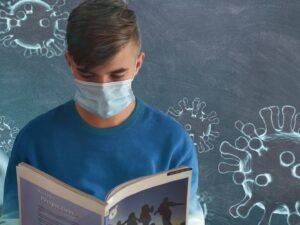
The Chatham-Kent and Lambton Public Health Units have teamed up to issue a joint letter to parents who are weighing their options over the return to school.
Officials say that while being in the classroom is good for students’ education and well-being, that doesn’t mean it’s what’s best for each family.
The letter warns that as we open more spaces for people to gather, like schools, there will be more cases of COVID-19, and the goal is not to prevent all cases, but contain outbreaks as they happen.
Read the full letter:
A Letter to Parents of School-Aged Children
Dear Parents/Guardians:
As you consider the decision to send your child or children to school, there are some important things to think about. Let’s start with two key principles to keep in mind. The first is that it’s a great idea for kids to be in school. It’s good for their education, good for their wellbeing, and good for the whole family. The second principle is that as we open up more spaces for people to gather (like schools), there will be more cases of COVID-19. The goal of living with this risk is that we cannot prevent all cases, but to try to contain outbreaks and to minimize the most severe outcomes. So that’s the starting point. But everyone’s situation is different, and the decision to send your kids to school in person needs to be one that works for you and your family.
First, think about the child that you will send to school.
Does that child have any medical vulnerabilities that may make them prone to severe disease if they get COVID-19? Mostly, children infected with COVID get a very mild illness and recover without much help. A very small number of children get a severe inflammatory disease, and we don’t yet know much about what puts kids at risk for that. What we can guess is that kids who already have underlying medical conditions may be more at risk – lung diseases like cystic fibrosis, cancer that may reduce their immune system, or diabetes that isn’t well controlled. Talk to your child’s health care provider about any conditions that might put them at greater risk if they were to get COVID-19. If your child is very medically fragile, returning to in-person school right now may not be the safest option. For most kids, the benefits of being in school will outweigh the risks to them.
Second, think about the people who live with your child.
Again, most people will recover without help if they get COVID-19. The people at risk for severe outcomes are those who are over 70, or have chronic diseases like diabetes, high blood pressure, heart disease or cancer. These people (including you) may need extra protection if you are living together in the same household. If there is a medically fragile person in the household, you will need to consider the risk to that person against the important benefits of sending your child to school. There is no perfect answer – make a decision that feels right to you now, and there will most likely be chances to change your mind later. Things that can help you lower the risk – have a family isolation plan to keep sick kids away from the vulnerable person in your house, and reduce the exposure of vulnerable people in your household to other social networks that could expose them to disease.
Third, public health will watch community transmission to help make decisions about the status of in-person learning.
Your school is committed to creating a caring learning environment, and public health will be working closely with school boards to identify and manage cases of COVID. We have been in close communication with school boards throughout the pandemic. Keeping community transmission low is key to keeping schools safer, and although there are no specific thresholds that define when a school should be closed, public health and the school boards will work together to decide on the ongoing status of schools.
Measures in place to protect children and educators in school will include:
-screening to ensure sick children and staff do not attend
-prompt isolation of sick children and staff
-physical distancing to the extent possible
-enhanced cleaning measures
-cohorting (keeping groups together) to the extent possible
-the use of face coverings for most students and staff.
If there are indicators of increased COVID-19 circulating in the local community or in Ontario, there will be provincial and/or local discussions to change course as needed. School boards and public health will do our best to keep you informed as these decisions are considered. There is no risk-free situation here. Sending your child to school may increase the risk of getting COVID-19. Keeping your kids at home may increase the risk of interrupting their social and developmental wellbeing. There is no right decision – only what is right for your child and your family right now. This system will need to be flexible and, whatever decision you make, we will continue to work together to help your children learn safely. By following public health measures and keeping your children home when they are ill, you will be helping to limit the spread of COVID-19 in schools.




